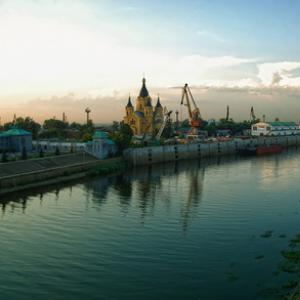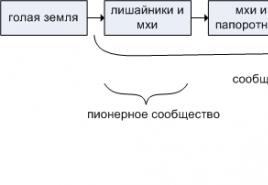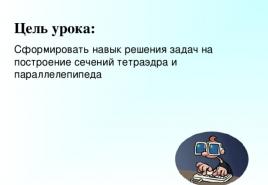Structural formula of iodine. The mysterious element iodine. Latin name for the substance Iodine
Iodine (Jodum), I (the symbol J is also found in the literature) is a chemical element of group VII of the periodic system of D. I. Mendeleev, belonging to the halogens (from the Greek halos - salt and genes - forming), which also include fluorine, chlorine , bromine and astatine.
The serial (atomic) number of iodine is 53, atomic weight (mass) is 126.9.
Of all the elements existing in nature, iodine is the most mysterious and contradictory in its properties.
Density (specific gravity) of iodine - 4.94 g/cm3, tnl - 113.5 °C, tKn - 184.35 °C.
Of the halogens found in nature, iodine is the heaviest, unless, of course, you count the radioactive short-lived astatine. Almost all natural iodine consists of atoms of one stable isotope with a mass number of 127. Radioactive 1-125 is formed as a result of the spontaneous fission of uranium. Of the artificial isotopes of iodine, the most important are 1-131 and 1-123: they are used in medicine.
The elemental iodine molecule (J2), like other halogens, consists of two atoms. Violet solutions of iodine are electrolytes (they conduct electric current when a potential difference is applied) since in the solution J2 molecules partially dissociate (break up) into mobile ions J and J. Noticeable dissociation of J2 is observed at temperatures above 700 ° C, as well as under the influence of light. Iodine is the only halogen that is in a solid state under normal conditions, and it appears as grayish-black plates or crystal aggregates with a metallic sheen with a peculiar (characteristic) odor.
A distinct crystalline structure, the ability to conduct electric current - all these “metallic” properties are characteristic of pure iodine.
However, iodine stands out among other elements, including differing from metals in its ease of transition into a gaseous state. It is even easier to convert iodine into vapor than into liquid. It has increased volatility and already evaporates at normal room temperature, forming a sharp-smelling purple vapor. When iodine is slightly heated, its so-called sublimation occurs, that is, it transitions into a gaseous state, bypassing the liquid state, then settles in the form of shiny thin plates; this process serves to purify iodine in laboratories and industry.
Iodine is poorly soluble in water (0.34 g/l at 25 °C, approximately 1:5000), but it dissolves well in many organic solvents - carbon disulfide, benzene, alcohol, kerosene, ether, chloroform, as well as in aqueous solutions of iodides ( potassium and sodium), and in the latter the iodine concentration will be much higher than that which can be obtained by directly dissolving elemental iodine in water.
The color of solutions of iodine in organic matter is not constant. For example, an iodine solution in carbon disulfide is purple, and in alcohol it is brown.
The configuration of the outer electrons of the iodine atom is ns2 np5. In accordance with this, iodine exhibits variable valence (oxidation state) in compounds: -1; +1; +3; +5 and +7.
Chemically, iodine is quite active, although to a lesser extent than chlorine and bromine, and even more so fluorine.
When slightly heated, iodine reacts vigorously with metals, forming colorless iodides salts.
Iodine reacts with hydrogen only when heated and not completely, forming hydrogen iodide. Iodine does not directly combine with some elements - carbon, nitrogen, oxygen, sulfur and selenium. It is also incompatible with essential oils, ammonia solutions, and white sedimentary mercury (an explosive mixture is formed).
When we mention iodine, most of us think of a small bottle and cotton wool. This is exactly how our mothers treated scratches and abrasions in childhood. And today you can find such iodine, the price at the pharmacy is a pittance.
Many adults know that iodine is a very important trace element. It affects the functioning of the thyroid gland and is involved in the metabolic process. Iodine-containing medications will have a price that is an order of magnitude higher than a bottle for treating wounds. What is iodine made from? And why is the price so different?
What is iodine?
Iodine is a mineral that is found in inorganic compounds: water, soil, and after rain it can be found in the air. It is also present in many foods of plant and animal origin. Thus, it is well known that there is a lot of iodine in kelp, as well as other seafood: fish, shellfish, crustaceans.
Iodine is also found in ordinary food products that are well known to us: eggs, beef, milk, butter, regular cabbage, other vegetables, and grains. The whole problem is that there is not enough of it in them. So, for example, cod liver (it is believed to contain a lot of iodine) contains 800 mcg of the mineral, and to meet the daily requirement, you need to eat 180 g of this product daily.
When deciding which is better - brilliant green or iodine, we don’t think about how important iodine is in a person’s daily life.
An adult needs 150 mcg of iodine per day, and pregnant women need 200 mcg. The norm for infants is 50 mcg, and for a schoolchild - 120 mcg.
Another problem associated with the delivery of this substance to the human body will be its destruction during the cooking process. So, during cooking, about 50% of this useful substance is lost. And in a month the pack will contain only 50% of the declared quantity.
Growing plants on soils poor in the mineral will significantly reduce its amount in the corresponding food products.
Here the solution to the problem can be called medical prices for them in the pharmacy, but are often far from publicly available.

Medical uses of iodine
Why is this mineral, found in very small quantities in the human body, so important for us?
It is only about 25 milligrams, but it plays a very important role for metabolic processes. Thus, about 15 mg of iodine is found in the thyroid gland and is part of the hormones triiodothyronine and thyroxine it produces. These hormones are responsible for many functions:
- have a stimulating effect on the growth and development of the body as a whole;
- regulate energy and heat exchange;
- participate in the oxidation of carbohydrates, fats and proteins;
- accelerate the process of cholesterol breakdown;
- regulation of cardiac activity is indispensable without them;
- they interfere with the process of blood clotting and the formation of blood clots;
- they are very important for the development of the central nervous system.
The remaining 10 mg is located in the reproductive organs - the ovaries (in women) and the prostate gland (in men), kidneys, liver, hair and nails.
A lack of this substance in a child’s body can cause a delay in his physical and mental development, and its excess will lead to poisoning called “iodism”, possibly to disruption of the thyroid gland, a terrible disease called “hyperthyroidism”.
The pharmaceutical industry produces different drugs for different purposes. Today, medications containing easily digestible iodine are expensive. And this is connected not only with the technological process of manufacturing the medicine, but also with the fact that the extraction of iodine itself is technologically complex and financially expensive.
Many people are interested in the simple question of what is better - brilliant green or iodine when treating fresh wounds? It should be remembered here that iodine will not only prevent the development of fungus and destroy the infection, brilliant green also copes well with this. It will promote faster healing of the wound - and in this case, iodine is more preferable.

Industrial uses of the mineral
Iodine is important not only for ensuring the normal human life cycle, it is used in many industries and is needed for the production of a large number of products.
So, with the participation of this substance, X-rays are taken, photographs are taken, added to bearing oil, glass for headlights and lamps with special effects are produced with its participation, it is needed to obtain high-purity metals.
Today, a new direction is developing in the production of incandescent lamps, where iodine plays an important role. Its use will significantly extend the service life of conventional incandescent lamps with a tungsten filament.
According to statistics, 99% of known iodine reserves are located in Japan and Chile, they are the main suppliers of it to the world market. Thus, Chilean companies produce over 720 tons of iodine per year.
Russia's production capacity allows it to produce up to 200 tons of raw mineral per year, which is 6 times less than the country's needs.

Extraction of iodine from seaweed
The question of the need for industrial production of this substance arose in the 18th century. Even then, it was noticed that marine plants have a high content of this important mineral. The first industrial production was the extraction of iodine from seaweed. In Russia, such a plant was built in Yekaterinburg (1915); it produced the mineral from phylloflora (Black Sea algae).
Today, the extraction of this raw mineral from algae is the most common method for obtaining iodine on an industrial scale. The production is built near the sea, during the process it is extracted from the ash of a dried sea plant. The largest enterprises extract up to 300 tons of crystalline mineral per year.
Sea kelp is considered to be the main source of industrial iodine production. It contains 0.8-0.16% iodine (in dry matter).
Isolation of mineral from nitrate waste
Isolation of iodine from mother brines of saltpeter production is one of the cheapest industrial methods. Here, to the question of what iodine is made from, the answer will be simple - from waste.
It was found that during production or sodium) up to 4 g of iodate and sodium iodide remain for every 1 kg of brine (this is 0.4%). The method has been used for more than 200 years all over the world, its main advantage is its low cost.

Obtaining iodine from brines
Another answer to the question of what iodine is made from would be the extraction of the mineral from natural inorganic raw materials - natural brines.
The fact is that when drilling oil wells in the accompanying waters, a significant amount of iodine was discovered, sometimes over 100 mcg per 1 liter, but generally not higher than 40. This feature of deep waters was discovered by Potylitsyn A.L (Russian chemist) in 1882, however, extracting the mineral from brines was expensive and economically unprofitable.
Industrial production began only in Soviet times after the invention of the coal method of iodine accumulation (1930). Coal is capable of accumulating up to 40 g of iodine per 1 kg per month. Now this is one of the main methods of extracting raw crystals in Russia.

Ionite mining
This technique is very widely used in Japan. The method is new and has become widely used only in recent decades. Here, high molecular weight ion exchange resins are used to extract raw materials.
However, in Russia it is not used, since it does not make it possible to extract all the iodine from the raw material and leaves a significant amount of it in waste.

Innovative techniques of V. Ganyaev
Recently, Professor V. Ganyaev developed a unique technology for extracting iodine from mineral water. In the summer of 2016, a special installation was created, and today it is successfully being tested.
According to scientists, the new technology is not only environmentally cleaner, but also more economically profitable; it does not use chloride compounds and sulfuric acid brines. When using it, the amount of raw mineral mined will be 24 g per 1 liter of concentrate.
So to the question of what iodine is made from, one can also answer that in Russia it is from mineral water. Although scientists believe that this technology will make it possible to use brines accompanying oil production much more efficiently.

How is medical iodine produced?
Today, a well-known antiseptic - alcohol 5% iodine - is being used less and less. It has been replaced by drugs where iodine is used in combination with starch.
If we consider the question of whether there is a difference in the production of technical iodine and medical iodine, then we should pay attention to the following.
- When producing raw material on an industrial scale, it is produced in the form of a crystalline mineral with a certain content of pure iodine (according to the periodic table).
- Medical iodine becomes such after combining raw crystals with other substances: water, alcohols, ethers.
Hence the conclusion: initially, iodine crystals are not divided into medical and technical - they receive this status in the process of further processing.
The price of iodine preparations in pharmacies depends not on the main component, but on those additional components that will be included in the medicine. The well-known bottle of antiseptic contains only iodine and ethyl alcohol, while, for example, drugs for the treatment of hyperthyroidism will be 2 orders of magnitude more expensive. They contain many other components.
Structural formula
Russian name
Latin name for the substance Iodine
Iodum ( genus. Iodi)Gross formula
I 2Pharmacological group of the substance Iodine
Nosological classification (ICD-10)
CAS code
7553-56-2Characteristics of the substance Iodine
Grayish-black plates or crystals with a metallic sheen with a characteristic odor; volatile, sublimes when heated. Slightly soluble in water, soluble in alcohol and in aqueous solutions of iodides.
Pharmacology
pharmachologic effect- hypolipidemic, antiseptic, distracting, antimicrobial.Coagulates proteins to form iodamines. Partially absorbed. The absorbed part penetrates tissues and organs and is selectively absorbed by the thyroid gland. It is secreted by the kidneys (mainly), intestines, sweat and mammary glands. It has a bactericidal effect, has tanning and cauterizing properties. Irritates skin and mucous membrane receptors. Participates in the synthesis of thyroxine, enhances dissimilation processes, has a beneficial effect on lipid and protein metabolism (reducing cholesterol and LDL levels).
Application of the substance Iodine
Inflammatory and other diseases of the skin and mucous membranes, abrasions, cuts, microtraumas, myositis, neuralgia, inflammatory infiltrates, atherosclerosis, syphilis (tertiary), chronic atrophic laryngitis, ozena, hyperthyroidism, endemic goiter, chronic lead and mercury poisoning; disinfection of the skin of the surgical field, wound edges, and surgeon's fingers.
Contraindications
Hypersensitivity; for oral administration - pulmonary tuberculosis, nephritis, furunculosis, acne, chronic pyoderma, hemorrhagic diathesis, urticaria; pregnancy, childhood (up to 5 years).
Use during pregnancy and breastfeeding
Side effects of the substance Iodine
Iodism (runny nose, skin rashes like urticaria, drooling, lacrimation, etc.).
Interaction
Pharmaceutically incompatible with essential oils, ammonia solutions, white sedimentary mercury (an explosive mixture is formed). Reduces the hypothyroid and goitrogenic effects of lithium preparations.
Overdose
When inhaling vapors - damage to the upper respiratory tract (burn, laryngobronchospasm); if concentrated solutions get inside - severe burns of the digestive tract, development of hemolysis, hemoglobinuria; the lethal dose is about 3 g.
Treatment: the stomach is washed with 0.5% sodium thiosulfate solution, sodium thiosulfate 30% is injected intravenously - up to 300 ml.
5. The thyroid gland needs iodine to produce the hormones thyroxine and triiodothyronine. Lack of iodine leads to swelling of the thyroid gland. Iodine deficiency is considered the main cause of mental retardation. Symptoms with an excess of iodine are similar to those that occur with a deficiency of this element. Iodine is more toxic to people with selenium deficiency.
6. Iodine forms diatomic molecules with the chemical formula I2.
7. Iodine is actively used in medicine. Some people have a chemical sensitivity to iodine. When iodine is applied to the skin, a rash may form. In rare cases, the use of iodine can lead to anaphylactic (allergic) shock.
8. Natural sources of iodine in the human diet are seafood and kelp (sea kale) growing in iodine-rich sea waters. Potassium iodine is often added to table salt. This is how iodized salt, known to many chefs, is obtained.
9. The atomic number of iodine is 53. This means that each iodine atom contains 53 protons.
Encyclopedia Britannica tells how iodine was discovered by mankind. In 1811, French chemist Bernard Courtois saw violet vapor when heating seaweed ash in sulfuric acid. This vapor condensed and became a black crystalline substance called “substance X.” In 1813, the British chemist Sir Humphry Davy, while passing through Paris on his way to Italy, suggested that “substance X” was a chemical element similar to chlorine and proposed calling it iodine (English: “iodine”) for its purple color. the color of its gaseous form.
Iodine never occurs in nature in a free state and is not concentrated in quantities sufficient to form an independent mineral. Iodine is contained in, but in small quantities as the I− ion in the composition of the salt of hydroiodic acid (iodide). The iodine content is approximately 50 milligrams per metric ton (1,000 kilograms) of seawater. It is also found in seaweed, oysters and cod liver. The human body contains iodine in the hormone thyroxine, produced by the thyroid gland. 
The only naturally occurring isotope of iodine is the stable iodine-127. The radioactive isotope iodine-131 with a half-life of eight days is actively used. It is used in medicine to test the functions of the thyroid gland, to treat goiter and thyroid cancer. And also for localizing brain and liver tumors. 
What iodine-rich seafood do you know? Do you consider seafood cooking not only healthy, but also delicious? It is believed that nori seaweed, which is used in making sushi, contains too much iodine and is therefore harmful to humans. How does this information affect your attitude towards the currently fashionable Japanese cuisine and does it affect it at all?







